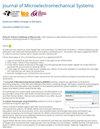Activation Model of Nano Getter for MEMS Devices Based on Sandwich Structures of Au-Porous Ti-Dense Ti Film
IF 3.1
3区 工程技术
Q2 ENGINEERING, ELECTRICAL & ELECTRONIC
引用次数: 0
Abstract
Ti-based nano Nonevaporable getters (NEGs) have become essential materials for maintaining a long-term high vacuum in Micro-Electro-Mechanical System (MEMS) devices. However, it is still a confusing issue how to select the annealing temperature and time for the getter activation on the basis of the required activation level, excessive temperature and time will damage the MEMS devices inside the package. Therefore, the relationship between the activation temperature, activation time and activation level gains more attention since it can give guidance for the vacuum packaging process, which currently lacks an effective quantitative model to be followed. This paper introduces a simple and efficacious model for determining the activation parameters according to Fick’s diffusion law and reports a sandwich getter with an ‘Au-Porous Ti-Dense Ti’ structure based on this model to improve the getter performances. Experimental results indicate that ~50% activation level is achieved for a 3mm基于au多孔Ti-致密Ti膜夹层结构的MEMS器件纳米吸气剂活化模型
钛基纳米不可蒸发吸收体(NEGs)已成为微机电系统(MEMS)器件中保持长期高真空的重要材料。然而,如何根据所需的激活水平选择getter激活的退火温度和时间仍然是一个令人困惑的问题,过高的温度和时间会损坏封装内的MEMS器件。因此,活化温度、活化时间和活化水平之间的关系受到更多的关注,因为它可以指导真空包装工艺,目前缺乏一个有效的定量模型可以遵循。本文介绍了一种简单有效的根据菲克扩散定律确定活化参数的模型,并在此基础上设计了一种具有“au -多孔Ti-致密Ti”结构的夹层吸气剂,以提高吸气剂的性能。实验结果表明,在300℃退火2小时的情况下,3mm × 3mm的三明治式吸气器达到了50%的活化水平,有望实现1 μ L微腔长达12年的高真空。这些结果与模型非常吻合,证明了对优化getter激活配方的价值,并提供了一种有效的方法来防止MEMS器件故障。[2024-0165]
本文章由计算机程序翻译,如有差异,请以英文原文为准。
求助全文
约1分钟内获得全文
求助全文
来源期刊

Journal of Microelectromechanical Systems
工程技术-工程:电子与电气
CiteScore
6.20
自引率
7.40%
发文量
115
审稿时长
7.5 months
期刊介绍:
The topics of interest include, but are not limited to: devices ranging in size from microns to millimeters, IC-compatible fabrication techniques, other fabrication techniques, measurement of micro phenomena, theoretical results, new materials and designs, micro actuators, micro robots, micro batteries, bearings, wear, reliability, electrical interconnections, micro telemanipulation, and standards appropriate to MEMS. Application examples and application oriented devices in fluidics, optics, bio-medical engineering, etc., are also of central interest.
 求助内容:
求助内容: 应助结果提醒方式:
应助结果提醒方式:


